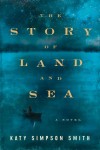Readers Advisory: Historical Fiction and the “Ick” Factor
 Katy Simpson Smith has received enviable attention for her first novel, The Story of Land and Sea, (Harper; HarperLuxe; HarperAudio, 8/26/14 ). Vogue magazine profiled the author, under the headline, “Katy Simpson Smith’s Luminous Novel Is Set to Be the Debut of the Year.”
Katy Simpson Smith has received enviable attention for her first novel, The Story of Land and Sea, (Harper; HarperLuxe; HarperAudio, 8/26/14 ). Vogue magazine profiled the author, under the headline, “Katy Simpson Smith’s Luminous Novel Is Set to Be the Debut of the Year.”
The Washington Post saw in the novel echoes of Hilary Mantel‘s Wolf Hall series, in that it “works to breathe life into history using the immediacy of the present tense. Its finely wrought (sometimes overwrought) language blends startling details of the everyday with a dreamy, aphoristic quality. The effect is to root the novel in its historical moment but to reach toward the universal in its exploration of love and grief.”
Wendy Bartlett, head of collection development at Cuyahoga P.L, Ohio, agrees that those details of daily life are “startling,” but not necessarily in a good way. She opened a discussion with branch staff about the book, via the following comments on the staff intranet.
Have you noticed the trend toward Realism with a capital “R” that has been hitting historical fiction? I get that living in 1793 was no picnic, but seriously, leave the ick factor to my imagination, okay?
I first noticed this with last year’s Longbourn by Jo Baker, a book I loved, but if there had been one more paragraph about chamber pots, I swear I’d have pitched it across the room. And Burial Rites by Hannah Kent. Great book as a long as you aren’t depressed when you start it, because trust me, you will be when you finish it. Did I really need to know how grungy Iceland was in 1829? I have been blessed with a great imagination. Oh, Writer. Trust your readers. We could have figured it out.
And now along comes The Story of Land and Sea, an excellent historical novel with lots of good historical detail woven in, lots of examination of how people in 1793 North Carolina thought and believed and therefore behaved differently than we do, which is superbly done, but ugh—when you get to the part about yellow fever. Again, Oh, Writer, I can color in those details myself.
I wonder if this is part of a larger cultural change. Are people so accustomed to visual entertainment that writers have to literally give us the gory details to make it real for people used to getting their mental pictures drawn for them on Xbox and HBO?
If your customers like extremely well written historical novels with carefully crafted character development, they’ll love The Story of Land and Sea, but if they are more to the Gentle Reader side of the scale, they’d be happier with Light Between the Oceans or The Invention of Wings.
Several of Cuyahoga staff members responded that they like those details, including Susan Levinsohn, who wrote,
I think we are more tolerant than we were even 10 yrs. ago for the reasons you mentioned above. Senior ladies are not asking for cozies like they used to and don’t mind reading the more graphic fiction. I also think many people that read historical fiction (including myself) like to read background information that does represent the times. I like to get a “feel” for the times and the people of the era as well as the story woven around it. I think if part of the appeal for the reader is the history then the details, however “icky” are more likely taken in as just true to the times. I like Miss Marple but I’ll take Burial Rites too.
As Wendy says, it’s important to understand your customers preferences when making recommendations.
